Alex Atala: A Peek at The World’s Most Interesting Chef
Ants are delicious. Seriously, or at least some of them are. Just ask Alex Atala, Chef-owner of the 6th best restaurant in the world D.O.M. in San Paulo, Brazil, who serves them on a raw pineapple cube. The affable, world-famous chef firmly believes that as a Chef you can’t have any preconceptions about food, nor can you stop searching for new flavors.
According to him, that’s the difference between a good cook and an excellent one. With the awards that he’s collecting, he’s apparently on to something. Let’s take a closer look at the former-DJ-turned-brilliant-chef who prides himself on serving up indigenous Amazonian ingredients in a style that’s all his own.

We spent some time with Chef Alex Atala at UCLA in Los Angeles and in Copenhagen at Noma and MAD Symposium. Our own Chef Javier Rodriguez cooked with Chef Atala at restaurant Noma for a couple of private dinners. They prepared a very simple dish consisting of artichokes and rice. Other chef who cooked that day was Danniel Patterson, from Coi restaurant in San Francisco.
Who Is Alex Atala?
Unassuming and precocious, Alex Atala is a man who obviously enjoys life and delights in sharing his culture with anybody who will appreciate it. Originally from the Amazonian region, Chef Atala works with scientists and anthropologists to discover and classify new flavors and fragrances from his home.
He’s part chef, part historian and part scientist both in the kitchen and as a man. Innovation is his way of keeping his world bright and fresh. Born in 1968, Alex Atala is a true child of the 70’s. His love of nature and his fellow man defines who he is; it’s difficult to separate the chef from the man because his food is truly a representation of who he is. Brazilian food created with native ingredients grown by local farmers is what you’ll find at D.O.M.; not because it’s a trend, but because that’s what he believes in!
To be global is to be local, he says. To go back to our roots, to eat and explore the foods we are surrounded with and yet use these ancient foods that we may have forgotten, in a multitude of new ways. He refers to world cuisine as the souvenir of a place. If you say soy sauce, miso and ginger, you think of Japan. Mozzarella, tomato and basil remind you of Italy. Chef Atala wants the world to recognize Brazil in the same way by just naming three Amazonian ingredients.
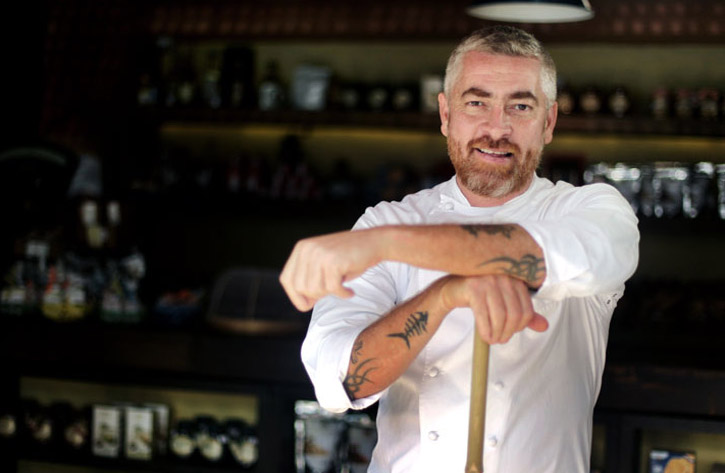
Physically, Chef Atala is a man who makes an impression. He has a flaming red beard and salt-and-pepper hair but the first thing that you notice is his wide-open grin that he readily shares. His many tattoos and piercings speak of a man comfortable in his own skin and you can’t wait to hear what he has to say. He knows who he is and his charisma and intensity are contagious.
When you hear Chef Atala speak, his earnestness and love of his homeland shine through so obviously that you can almost smell the rainforest. This is most likely a huge contributing factor to why Time named him one of the World’s Top 100 Most Influential People.
Chef Atala learnt in classic restaurants in France, Belgium and Italy. Already at age 19, in the Hospitality School of Namur, in Belgium, Atala began his career as a professional chef. In France, he worked in restaurants such as the ones owned by Jean Pierre Bruneau and Bernard Loiseau, and was a trainee at the renowned Hotel de la Cote D’Or. He next left for new challenges in kitchens of Montpellier and Milan. Back to São Paulo in 1994, he soon drew attention for his performance while in charge of the restaurants Filomena and 72. In 1999, he began his career as chef-owner in the acclaimed Namesa. In the very same year he opened the D.O.M.
Because of his intense love for his native ingredients, his easy speaking style and his innovative perspectives, Chef Atala isn’t just the toast of the culinary world. He’s also in high demand in academic circles, at food conferences and in lecture halls around the world.
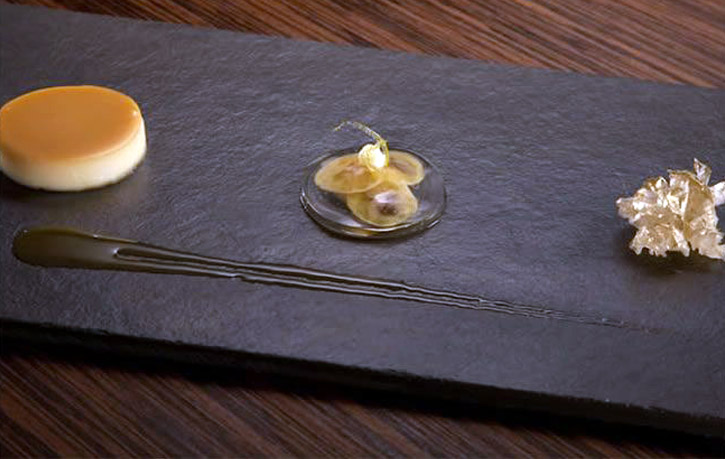
Innovation: Creativity and Utility
He recently gave a lecture at UCLA in front of Professor Amy Rowat’s “Science and Food: The Physical and Molecular Origins of What We Eat” students and the general public. The class features world-class chefs and farmers from around the world in an effort to introduce food science to non-professionals and people outside of the field.
During the lecture, he used his vegetarian tasting menu to highlight that innovation wasn’t necessarily dependent upon new ingredients, but also upon how you used common ingredients. He stressed that in order to continually progress, it’s important to break the conditioning cycle of using the same ingredients in standard, comfortable ways. It’s great to use humble ingredients but don’t disrespect them by treating them as such. For a chef, conditioning and reflex can feel comfortable but they can also hinder innovation.
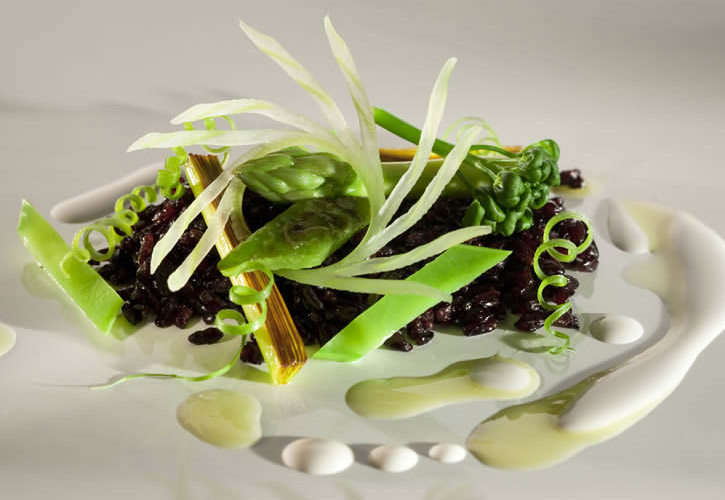
Atala believes that a chef's creativity does not lie solely in creating something completely new, but rather creating something that is unexpected to people. It's about integrating what is already known into something totally new. "Old ideas can be much cleverer, intelligent and modern than new ideas.” Atala said. “It’s all in the utilization…. It’s not necessarily when it was invented or discovered that matters - it is how useful it is. The key to modern flavors is looking at, and using, old flavors in new ways.''
As an example, he shared with us a dish made of yucca flour, local herbs and chili which is just an old dish from local tribes in the Amazonas with his own twist that has never been served before in a high end restaurant.
Context: Would You Eat Vomit?
Chef Atala talks about context in cooking and how preconceptions are what prohibit us from experiencing new things in a unique manner. Many expensive cheeses smell like old sweaty shoes and people love them. “Would you ever consider eating vomit? Have you eaten honey? Well, that’s the vomit of a honeybee.” Atala says. What is delicious and what seems revolting is a matter of context, Atala concludes.
When he was hiking in Nepal, eating only vegetables for 15 days, he started smelling barbecue from a nearby village. ''It smells wonderful, our mouths salivated, we felt, you know, we deserve a nice piece of barbecued meat''. But it was the smell of a burning corpse in a traditional death ceremony. They were no longer hungry. He compares the Maillard reaction that occurs when we grill a steak and results in the caramelized and meaty aromas we all love with the chemical reaction that occurs when burning human remains in a funeral pyre. “It is the same chemical reaction”, he says.
Chef Atala was in the Amazonas when he met a lady who gave him a bowl of soup and asked him to try it. Chef Atala immediately recognized the flavors of lemongrass, cardamom and ginger. The woman said ”This is just ants, nothing else”, to Atala’s surprise. Atala then returned with some lemongrass, cardamom and ginger to show the woman the similarities and the woman said “the ant doesn’t taste like lemongrass and ginger; lemongrass and ginger taste like ants! “
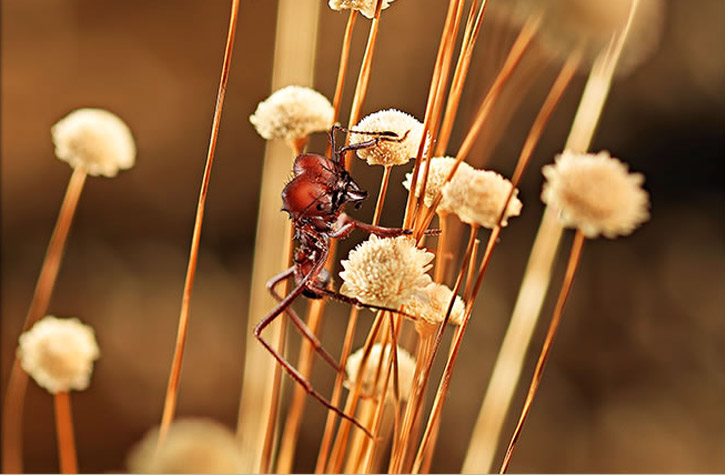
Eating insects is common to cultures in several parts of the world, especially in Eastern countries. But did you know that you probably already ate insects without knowing? By law, common packaged foods are allowed to have a percentage of insect parts. And the red dye carmine commonly used for food coloring around the world is from an insect called cochineal that is dried and mixed with calcium salts.
Conservation: Atala Kills a Chicken at MAD Symposium
One of Chef Atala’s firmest beliefs, and perhaps his raison d’etre, is that food is the link between nature and culture. He advocates passionately for the protection of Brazil’s natural resources, including those in his beloved Amazon. To that end, he works closely with anthropologists, scientists and non-profits to preserve the environment. He readily and tirelessly shares both his philosophies and his cuisine to educate people.
“My mise en place starts with protecting the land, the forests, and the sea,” he says. Chef Atala also communicates his beliefs through his creative dishes. In the yucca flour dish we mentioned before, for example, he garnishes it with a few drops of bitter charcoal oil to remind diners about the origin of the dish and the problematic burning of the Amazonian rain forest. The charcoal oil is made by infusing neutral oil with still glowing embers of wood.
Chef Atala believes that we need to start eating entire ingredients: "We need to learn how to eat an entire ingredient, it is more than just reducing waste, it’s about being respectful to the environment.”
To drive home the fact that your food comes from living resources that are to be respected, he showed up to MAD3 Symposium in Copenhagen in a T-Shirt that read, “Death Happens” and proceeded to kill the chicken, then cooked it and served it. The effect was dramatic but effective. The people that were there will have a difficult time NOT making that connection in their minds again. Message delivered, loud and clear.
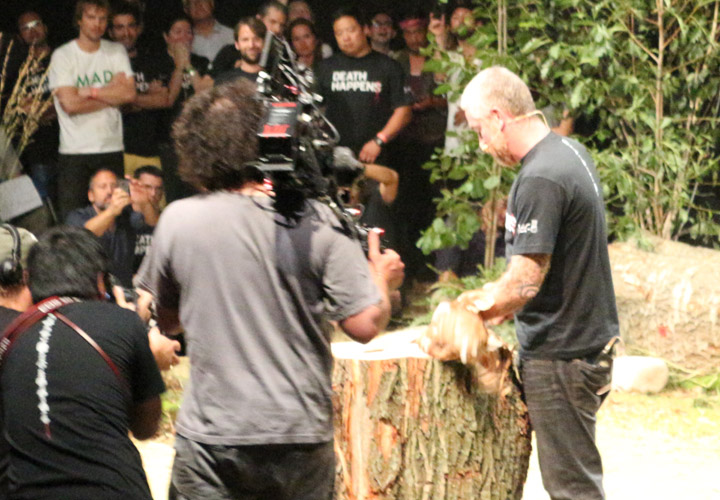
The Restaurant
D.O.M. is an anagram for Deo Optimo Maximo which, roughly translated, means “To the Greatest and Best God”. Statistically, it’s located in Sao Paulo, Brazil and is ranked #6 on San Pelligrino’s World’s Best Restaurants List and #2 on Latin America’s 50 Best Restaurants List and has two Michelin stars as of 2013. Excellent accolades to be sure, and ones to be proud of, but D.O.M. is way more than an award-winning restaurant. It’s an extension of the love and graciousness of Alex Atala himself.
Sharing local ingredients in innovative new ways is the hallmark of D.O.M. food. In fact, standard fare such as caviar and foie gras typically found in high-end restaurants is banned at D.O.M. Instead, Chef Atala serves brilliantly modest dishes that stretch the limits of science while highlighting the bounty available in his beloved Amazon. He likes to focus on just a few flavors and ingredients in each dish.
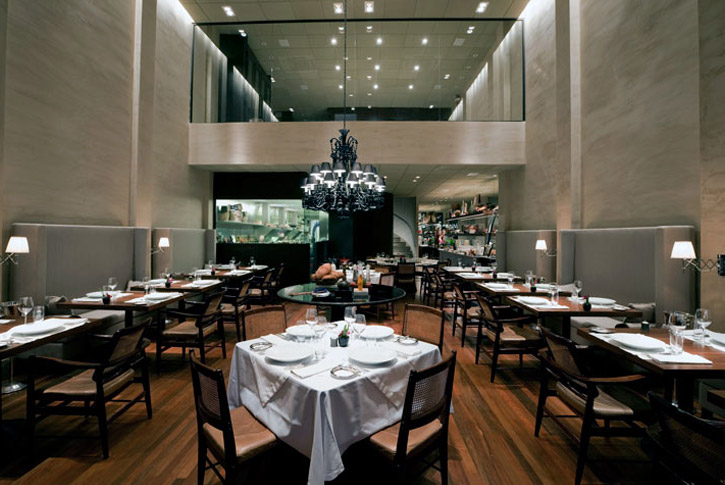
The Amazonian Ingredients
Ants, priprioca, sustainable heart of palm, bacuri and jabuticaba: what are these masked flavors? Ingredients from the Amazon, of course, and some of Chef Atala’s favorite tools.
Amazonian Ants
As we mentioned before Chef Alex Atala dishes are simple and focus on just a few flavors and ingredients. A perfect example of this is one of D.O.M.’s signature desserts with just two ingredients – fresh pineapple garnished with a dried ant. The ant could have been powderized or mixed with something else to make it more visually appealing but to make his point that it is all about context and preconceptions, the ant just rests on a ‘pedestal’ of pineapple so you can really appreciate it.
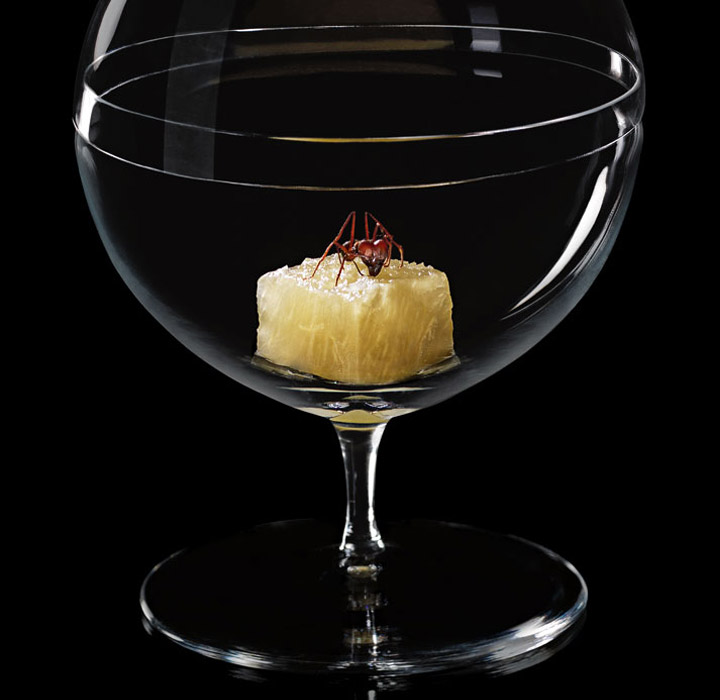
We tried this dish with some skepticism but were positively surprised by the familiar flavors. We were expecting to experience some odd taste or at least something different, but we just perceived the clear flavors of pineapple, lemongrass and ginger. The only odd thing and slightly unpleasant was that some of the ant legs would stay between your teeth and around the mouth after swallowing the bite.
Priprioca
Priprioca is a root that’s often used in cosmetics but is now finding its way to your plate. It has an earthy, hempy flavor and is one of the star ingredients in D.O.M.’s Banana, Lime and Priprioca Caramel Ravioli dessert (recipe coming soon). During the lecture at UCLA, he gave us chocolate cream with priprioca to taste. You first taste the chocolate but then the complex earthy notes of the priprioca come forward making this a distinctive bite.
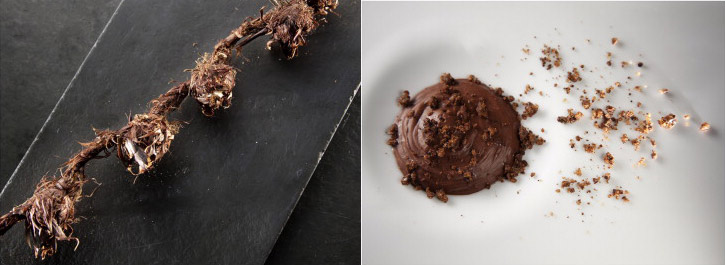
Bacuri and Jabuticaba
Bacuri and jabuticaba are Amazonian fruits. Bacuri looks similar to a wilted lemon and has a soft, white pulpy center that tastes a little citrusy. Some people compare it to lemon cotton candy, sort of. Jabuticaba has been compared to a purple grape both in appearance and texture. It has a fruity taste as well and is often used in jams and tarts.
Heart of Palm
Harvesting heart of palms usually kills the palm tree. But Chef Atala uses a specific wild heart of palm that is sustainable and, like all of the others, is Amazonian. This palm species is a clonal or multi-stemmed plant that won’t die with modest harvesting. It has an earthy, slightly cabbage-like flavor that goes well with many different ingredients depending upon how you cook it. It’s the star ingredient in D.O.M.’s Heart of Palm Fettuccine with Butter and Sage, Parmesan Cheese and Popcorn Powder that he so kindly shared with us (get Heart of Palm Fetuccine recipe here).
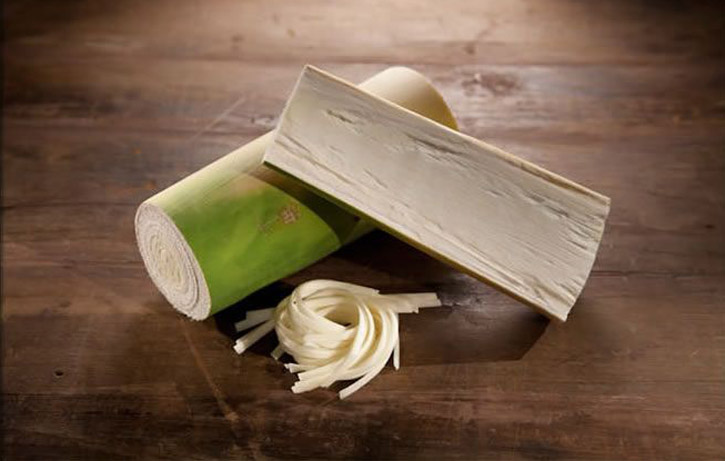
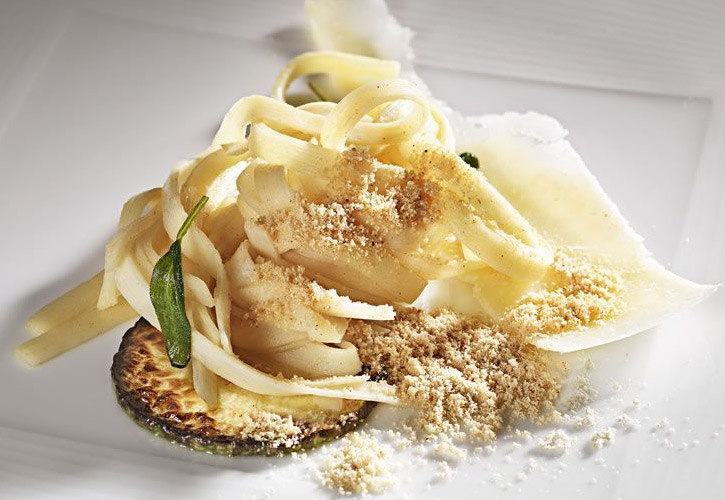
D.O.M.: Rediscovering Brazilian Ingredients by Alex Atala
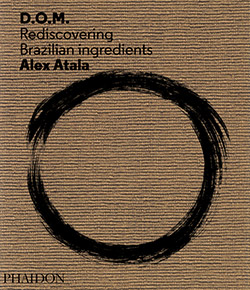 If you want to learn more about Chef Alex Atala, his new book was just released. In D.O.M.: Rediscovering Brazilian Ingredients
If you want to learn more about Chef Alex Atala, his new book was just released. In D.O.M.: Rediscovering Brazilian Ingredients Chef Atala shares the thoughts, ideas and ideology that help him to create his uniquely Brazilian dishes. Any food lover with an interest in Brazilian cuisine will consider this cookbook a must-have.





